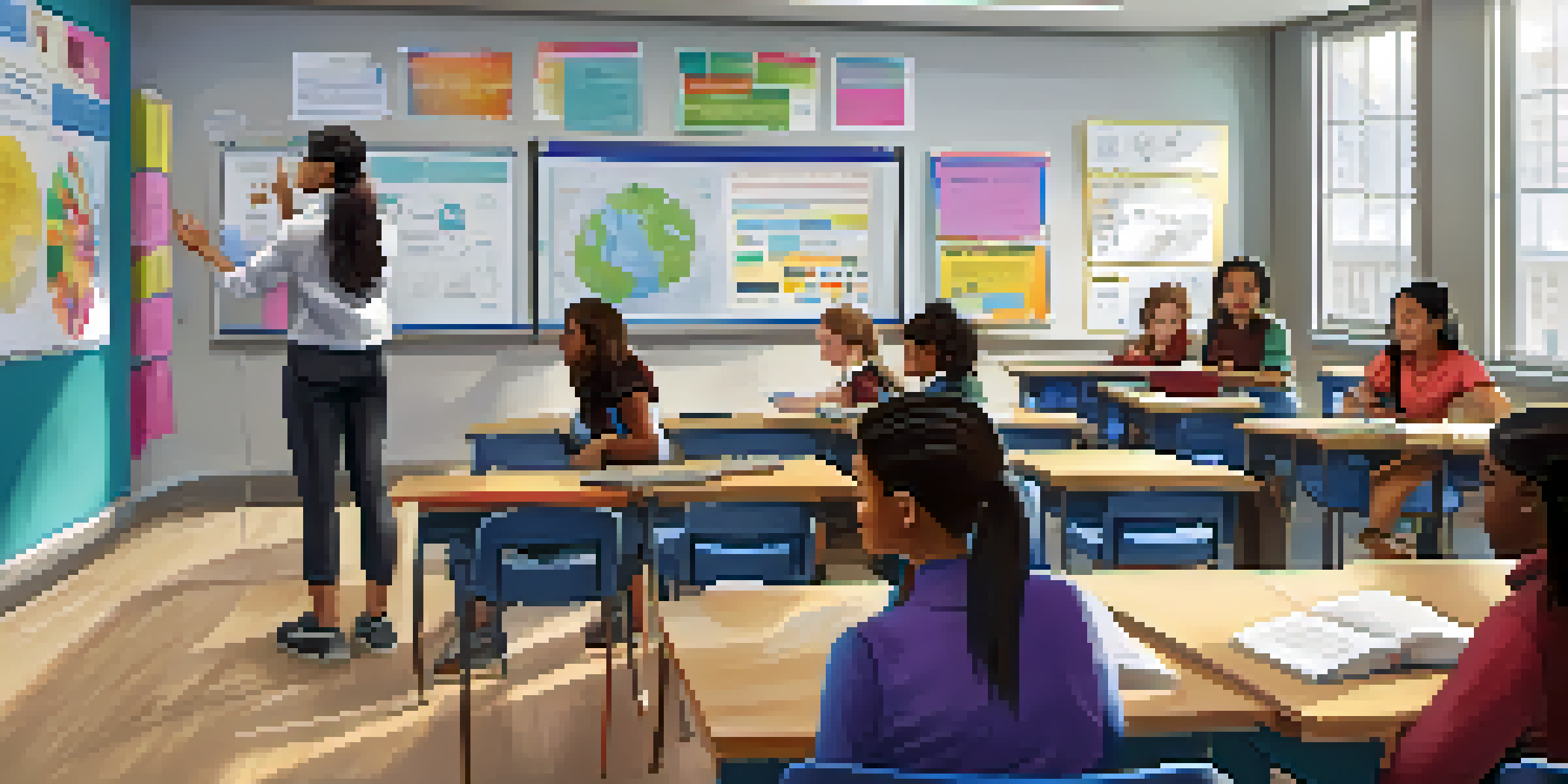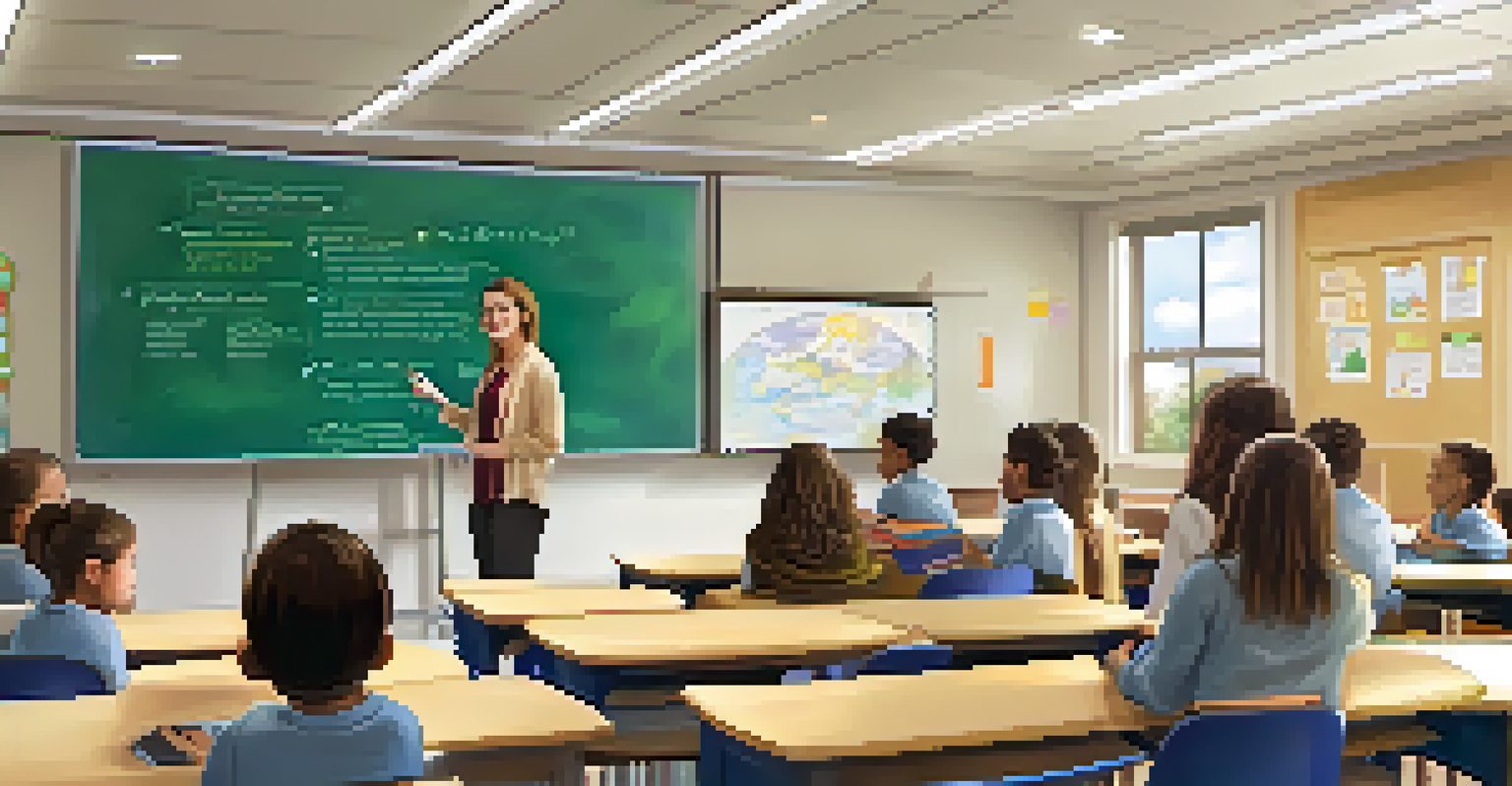Blended Learning Models: Merging Traditional and Digital

Understanding Blended Learning: A Seamless Integration
Blended learning combines traditional face-to-face instruction with digital learning methods, offering a more flexible approach to education. This model allows educators to tailor lessons to meet the diverse needs of their students while leveraging technology. For instance, a teacher might conduct a lecture in class, then assign related online modules for students to complete at their own pace. This fusion of learning environments not only caters to different learning styles but also encourages active participation.
Blended learning is not about the technology; it's about the learning.
The beauty of blended learning lies in its adaptability; it can fit various educational settings, from K-12 schools to higher education institutions. By incorporating technology, students can engage with materials outside the classroom, allowing for deeper exploration of topics. Imagine a student who struggles with a math concept—by accessing online tutorials or resources, they can revisit challenging material as often as needed, promoting mastery and confidence.
Moreover, blended learning fosters collaboration among students. Online platforms can facilitate group projects where students can communicate and share ideas beyond school hours. This helps create a learning community that extends beyond the classroom walls, ultimately enhancing the educational experience.
Key Components of Blended Learning Models
There are several key components that define effective blended learning models. These include face-to-face instruction, online content delivery, and ongoing assessment. By blending these elements, educators can create a balanced approach that supports various learning objectives. For example, face-to-face sessions can focus on complex discussions, while online modules can cover foundational knowledge in a self-paced manner.

Another important aspect is the use of technology to facilitate learning. Learning management systems (LMS) play a crucial role in delivering content, tracking progress, and providing feedback to students. These systems can also help teachers analyze student performance data, allowing them to make informed decisions about instructional strategies. Picture a teacher who notices a trend in student scores—this insight can prompt targeted interventions to support those who may be struggling.
Blended Learning Enhances Flexibility
By combining traditional teaching with digital methods, blended learning offers a more adaptable educational experience that meets diverse student needs.
Additionally, effective blended learning models incorporate opportunities for student choice and autonomy. By allowing students to select how they engage with materials, educators can foster a sense of ownership over their learning. This not only boosts motivation but also cultivates essential skills like time management and self-discipline.
Popular Blended Learning Models to Explore
Several popular blended learning models have emerged, each with its unique structure and approach. The Station Rotation model, for example, involves students rotating between different learning stations—some led by a teacher, while others are independent or technology-based. This method allows for a more dynamic classroom experience, as students can switch between collaborative and individual tasks.
The best blended learning environments combine the best of both worlds—face-to-face interaction and online learning.
Another widely used model is the Flipped Classroom, where traditional lecture content is delivered online, allowing class time to be dedicated to hands-on activities and discussions. This shift in teaching strategy not only maximizes classroom engagement but also encourages students to take responsibility for their learning. Picture a classroom where students arrive prepared with questions and insights, ready to dive deeper into the subject matter.
Lastly, the Flex model offers a high degree of personalization, with students accessing online content at their own pace while receiving teacher support as needed. This model is particularly beneficial for diverse classrooms, as it accommodates varying levels of proficiency and preferences. Imagine a student who can accelerate through subjects they excel in while taking additional time on more challenging topics.
Benefits of Blended Learning for Students
Blended learning offers numerous benefits for students, making it an appealing educational approach. One significant advantage is enhanced engagement—by integrating technology, lessons become interactive and dynamic. Students are more likely to stay motivated when they can participate in discussions online, watch videos, or engage in gamified learning experiences.
Additionally, blended learning promotes self-directed learning. With the availability of online resources, students can take charge of their education, exploring topics that interest them or revisiting materials they find challenging. This autonomy not only boosts confidence but also prepares them for lifelong learning beyond the classroom.
Key Models Foster Student Engagement
Popular models like the Flipped Classroom and Station Rotation promote active participation, allowing students to take control of their learning.
Moreover, blended learning can improve academic performance. Research shows that students who engage in blended learning often outperform their peers in traditional settings. By providing varied instructional methods and allowing for personalized pacing, blended learning creates an environment conducive to success.
Challenges of Implementing Blended Learning Models
While blended learning models present exciting opportunities, they also come with challenges that educators must navigate. One major hurdle is ensuring that all students have access to the necessary technology and reliable internet. In some cases, disparities in access can hinder participation, making it crucial for schools to address these gaps to create an equitable learning environment.
Another challenge is the need for professional development for educators. Teachers must be trained not only in the technology itself but also in effective instructional strategies that blend traditional and digital methods. Imagine a teacher who is enthusiastic about implementing a new online tool but struggles to integrate it meaningfully into their lessons—this highlights the importance of ongoing support and training.
Lastly, managing the balance between online and in-person instruction can be tricky. Educators must find the right mix to ensure that students benefit from both learning environments. This requires careful planning and flexibility, as teachers continuously assess what works best for their students and adjust accordingly.
The Role of Educators in Blended Learning
Educators play a pivotal role in the success of blended learning models. They are not only facilitators of knowledge but also guides who help students navigate their learning journeys. By creating a supportive and inclusive environment, teachers can encourage students to take advantage of the opportunities that blended learning provides.
Moreover, effective educators are adept at leveraging technology to enhance their teaching. They understand how to integrate digital tools in ways that enrich the learning experience rather than distract from it. For instance, a teacher might use interactive simulations to illustrate complex scientific concepts, making them more accessible and engaging for students.
Technology's Role is Crucial
Access to technology and effective training for educators are vital for successfully implementing blended learning and ensuring equitable opportunities for all students.
Lastly, educators must remain flexible and responsive to the needs of their students. This means being open to feedback and willing to adjust their instructional strategies as necessary. When teachers foster a culture of adaptability, students feel empowered to take risks and explore new ways of learning.
The Future of Blended Learning in Education
As technology continues to evolve, so too will the landscape of blended learning. The potential for innovation in educational practices is vast, with new tools and resources constantly emerging. This evolution will likely lead to even more personalized and engaging learning experiences for students, breaking down the traditional boundaries of the classroom.
Furthermore, the ongoing shift toward online education, accelerated by recent global events, has opened the door for blended learning to become a mainstay in educational systems. Schools are increasingly recognizing the need for flexible teaching methods that can adapt to various circumstances, making blended learning an attractive option for the future.

Ultimately, the future of blended learning is bright, with the promise of enhancing educational outcomes for all students. By embracing this model, educators can create a more inclusive, engaging, and effective learning environment that prepares students for success in an ever-changing world.